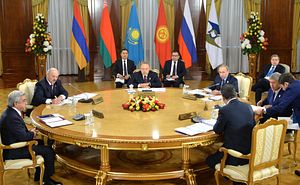The Eurasian Economic Union and Vietnam finally have a solid date for the enforcement of their free trade agreement. While the EEU will tout the agreement as its first trade pact outside the union’s members, the fact of the matter is that the EEU inherited the negotiations. When negotiations began in 2013, Vietnam was in discussions with the Russia-Belarus-Kazakhstan Customs Union. The EEU launched formally on January 1, 2015.
The trade agreement was signed in May 2015 after eight rounds of negotiations. In May 2016, both Vietnamese and Russian authorities seemed hopeful that the agreement would go into full force in June.
“The government of Vietnam welcomes the fact that the president of Russia has already signed the law ratifying the free trade agreement between the Eurasian Economic Union and Vietnam. I think that the agreement will become fully operational this June and I am fully confident that the implementation of this agreement will create a surge in our relations,” Vietnam’s prime minister Nguyen Xuan Phuc said in May.
Andrei Slepnev, minister of trade of the Eurasian Economic Commission, said in April that the agreement would come into force 60 days after ratification.
Four months later, a new date has been floated: October 5.
The enthusiasm for a summer launch did not factor into consideration the EEU’s many members. Kazakhstan ratified the agreement first, followed by Russia in early May. Belarus and Kyrgyzstan ratified by the end of May and Armenia ratified in mid-June.
The new date was announced by the Vietnamese Ministry of Industry and Trade. Russia’s First Deputy Prime Minister Igor Shuvalov confirmed the date. Per TASS, Shuvalov said, “We’ve discussed the most important and complicated issue of the launch of the free trade zone agreement between the EAEU and the Republic of Vietnam. All domestic procedures in the EAEU member-states and Vietnam have been finalized and we realize and confirm that the agreement in coming into force starting from October 5 of this year.”
When the agreement was signed in 2015 then-Chairman of the Board of the Eurasian Economic Commission Viktor Khristenko said the comprehensive agreement was expected to boost trade between Vietnam and Eurasia to more than US$10 billion by 2020 from its present level around $4 billion.
For Vietnam, the trade agreement is expected to open new markets in Eurasia for a range of goods: farm products, seafood, textiles, footwear, and processed food. EEU members–particularly Russia–are looking to sell technology, mineral resources and cars. While the agreement will reduce and in some cases eliminate customs duties on 87 percent of goods traded between the two parties, the benefits may be unevenly spread across the members of the EEU.
Russia and Vietnam look set to best capitalize on the deal. For example, an article in Russia Beyond the Headlines highlights the opportunities for Russia’s automakers and for Vietnamese garment and food product exporters. The benefits for smaller EEU members, like Kyrgyzstan, are less clear. Kyrgyzstan’s exports to Vietnam are negligible, as are its imports. An optimist would say, “there’s room for growth then!” But a pessimist would point to the likely flood of cheaper Vietnamese products on Kyrgyz shelves as not quite the benefit Bishkek would hope for.

































